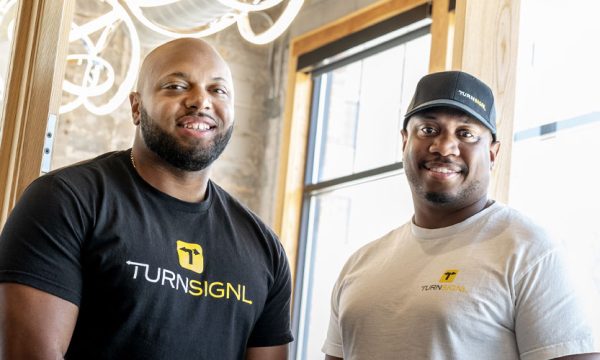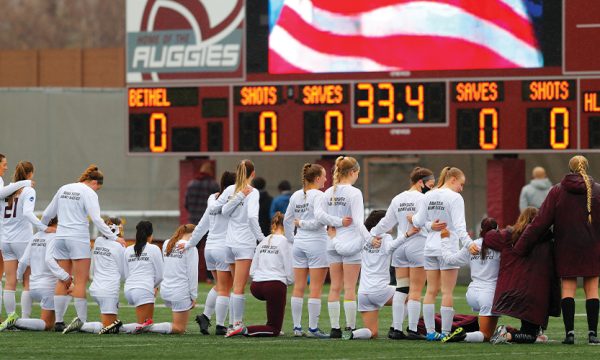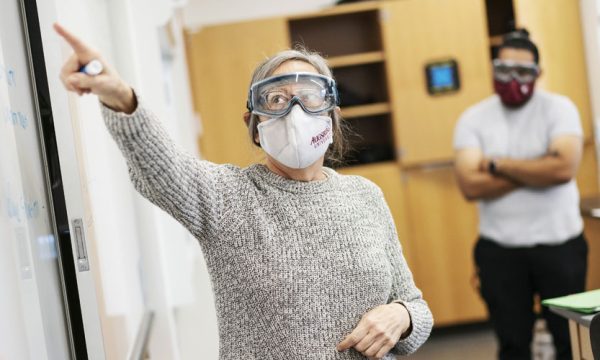 You’ve seen the story on TV or heard it on a true crime podcast.
You’ve seen the story on TV or heard it on a true crime podcast.
A crime is committed. An eyewitness identifies a suspect in the lineup. The suspect is prosecuted and relegated to years of incarceration. Justice is served … until DNA evidence exonerates the suspect.
Augsburg University Professor of Psychology Nancy Steblay believes these crucial questions deserve answers: How reliable is eyewitness identification, and how trustworthy are the law enforcement procedures that collect eyewitness evidence?
“I was trained as a social psychologist. As I was teaching after graduate school, I saw that many of the principles I’d learned about social psychology and experimental methods really applied to this area of psychology and law,” said Steblay, who is entering retirement after 32 years at Augsburg. “What became interesting to me are principles through which we could change the justice system.”
Activists and community leaders in the United States have long decried the injustices of racial discrimination and violence perpetuated in the criminal justice system. More than six years before Minneapolis police killed George Floyd, prompting a growing number of citizens and leaders to call for greater accountability for law enforcement officers—with some calling into question the legitimacy of police policies and even police presence as a whole—Steblay and her team collected data, evaluated methods, and drew scientific conclusions about a specific mechanism within the law enforcement system that many believe is, at the very least, in desperate need of reform.
That component of the justice system is the police practice of lineups: a law enforcement process designed to confirm an eyewitness’s identification of a criminal suspect among a lineup of several people with similar appearance, build, and height as the suspect. However, this process is far from flawless.
Mistaken eyewitness identification is observed in seven of every 10 cases when the true identity of the criminal is revealed by forensic DNA testing, said Gary Wells, an Iowa State University psychology professor who collaborated with Steblay. “It’s a national problem and has major implications for our criminal justice system and our belief in the reliability of that system.”
Real People in Real Cases
Eyewitness identification of criminal perpetrators is a staple form of evidence in courts of law.
“Think of eyewitness memory like trace evidence, such as blood, gunshot residue, or other physical evidence,” Steblay said. “You don’t want to contaminate it.”
Steblay, along with Wells, is among the top national experts in eyewitness identification. As an experimental social psychologist who has conducted research on eyewitness memory, police procedures, and eyewitness evidence for 30 years, she is often called upon by defense attorneys to testify when they believe a suspect is being wrongly accused based on faulty identification.
Her ability to speak with authority on the subject has been reinforced by her research findings. Assisted by Augsburg student researchers, Steblay and Wells led studies that, for the first time, sought to understand and predict eyewitness identification errors using actual lineups.
Before these studies, scientific psychology’s understanding of eyewitness identification accuracy was based almost exclusively on controlled laboratory studies that simulate eyewitness experiences.
Steblay and Wells were awarded a National Science Foundation grant to pursue a four-phase study from 2014-2018. The research followed up on their prior work, in which police lineups were presented to real eyewitnesses by detectives using laptop computers with a software program developed specifically for the field experiment. Data was collected from 855 lineups in four cities: Austin, Texas; Charlotte-Mecklenburg, North Carolina; San Diego; and Tucson, Arizona.
The field data collected in these cities provided lineup photos and eyewitness identification decisions, investigator reports, and audiotapes of the verbal exchange between the lineup administrator and eyewitness during each lineup procedure. A startling discovery emerged from a pattern of cases when lineup administrators, who were also the case detectives, knew who the suspects were and behaved in a leading fashion with the eyewitnesses.
Learning From Lineups
Augsburg student researchers collected data and assessed 190 real lineups for fairness or bias. “It’s powerful to bring students into research by saying, ‘Here’s the problem of wrongful convictions, and let’s figure out how to solve them,’” Steblay said.
Psychology majors made up the research team at Augsburg, adding laboratory skills to what they learned in the classroom. Steblay and 27 student researchers conducted the first and second studies across multiple semesters.
Verbal exchanges between police lineup administrators and eyewitnesses to crimes were audio-recorded. There had never been an analysis of recorded verbal comments from actual witnesses because such recordings had never existed until this study.
The Augsburg students coded 102 audio transcripts to examine the association between witness comments and lineup selection, finding that an instant identification by an eyewitness was less likely to produce an error than when the witness was deliberative.
Natalie Johnson ’18, who’s pursuing a master’s degree in counseling psychology at the University of St. Thomas in St. Paul, Minnesota, was one of the students who listened to police audiotapes and coded them based on whether the decision-making process was immediate or deliberative.
She and other students were startled to realize that the police push for a conviction could, in some cases, influence how criminal cases are pursued.
“Doing the work on police lineups made me realize how flawed our system can be,” she said. “It made me realize our criminal justice has a long way to go.”
Sean Adams ’17, who is currently a legal assistant, said he was shocked by how poorly some of the lineups were constructed.
The tests were designed to include fake witnesses, and these mock witnesses in Augsburg’s laboratory studies represented the worst possible scenario: a witness with no memory of the offender. Mock witnesses should not be able to pick the police suspect from a lineup at a rate higher than chance. “The worst lineup I saw had such a leading description that the [laboratory] witnesses picked the police suspect 80% of the time,” Adams said. “That should have statistically been less than 20% of the time.” Lineups should be constructed so that the suspect and the fillers (innocent people added to the lineup) match the suspect description.
Relevant Research
Along with stunning insights into eyewitness identification, these studies brought to light more questions worth exploring. The research resulted in 12 conference poster presentations involving 23 students, and it fostered two student honors projects and spinoff projects that are ongoing.
“It was time-consuming, but it was important. I think the student researchers had a sense of the importance,” Steblay said. “It was really fun to work with them. Their work enabled me to complete the project.”
Augsburg student researchers saw the subject material’s importance for effective law enforcement practices as well as its resonance with people beyond their research group. When Austin Conery ’17 began researching how to predict eyewitness identification errors, he discovered that his Augsburg University research project was a hot topic with friends and family.
“Every party or every family event, someone would ask what was going on at school, and I could talk about the research for hours because it was so relevant,” Conery said.
Besides a view into a major criminal justice system issue, students said the research opportunity gave them practical experience.
Conery said the research gave him the confidence to read, understand, and apply studies in his current job as a site director at a children’s mental health provider, PrairieCare. “It was a great way to implement the things I was learning in class,” he said. “It gave me the place to think critically in a controlled environment.”
As Adams considers his future work, he’s looking back to his time at Augsburg. “I’ve been thinking of what I enjoyed in college, and a lot of it was the work I did with Nancy,” he said.
Turning Research Findings into Practical Policies
Steblay’s influence may not make her a household name, but her research findings are being put to practical use in a variety of ways.
Minnesota judges view a webinar module she created, “Eyewitness Science: Protection and Evaluation of Eyewitness Identification Evidence,” as part of their judicial e-learning program. Steblay also published a chapter in the 2019 book, “Psychological Science and the Law.”
The findings of the research by Steblay, Wells, and Augsburg student researchers are leading to major reforms nationally. The best practices include critical stipulations: that lineups must be double-blind, meaning the administrating officer doesn’t know who the suspect is, and that the non-suspect fillers in the lineup must resemble the suspect and match the description of the offender that was provided by the eyewitness.
“There are hundreds of thousands of police officers who are using these eyewitness identification protocols that we didn’t use 20 years ago, and they don’t know Nancy Steblay’s name,” said William Brooks, a police chief in Norwood, Massachusetts.
Brooks travels the country training police on what he regards as groundbreaking science-backed best practices for lineups. “I don’t think there’s been as wide of an impact in other areas of investigation as in how we deal with eyewitness memory,” he said.
In mid-May, Minnesota Gov. Tim Walz signed bipartisan legislation that requires uniform science-backed eyewitness identification practices for all law enforcement, which goes into effect in early 2021.
Still, the eyewitness identification best practices face resistance. “Some of it is individual police jurisdictions just not wanting to be told how to do things,” Steblay said in an interview with Yahoo News. “Sometimes police or prosecutors say they don’t want rules to be so rigid, because then if we just violate one of the rules, then that ruins our prosecution or we can’t catch the bad guys or whatever. So they feel like it’s undermining their ability to do the good job that they should do.
“I don’t see it that way,” Steblay said. “I just think these are not difficult changes.” Steblay views the recommended lineup reforms as a means to strengthen eyewitness evidence and reduce the likelihood of a mistaken identification.
The Innocence Project, a nonprofit founded in 1992 to exonerate the wrongly convicted through DNA testing, has worked to pass laws throughout the country that embrace the scientifically supported best practices advanced by Steblay and Wells.
“When we began our work, a handful of states had embraced best practices. Today more than half of the states in the country have adopted key eyewitness identification reforms,” said Rebecca Brown, the nonprofit’s policy director.
Steblay hopes more police departments will enact these reforms. “We have at least part of the answer to how police can reduce mistaken identification and wrongful convictions.”
Reforms in action
States where core eyewitness reforms have been implemented through legislation, court action, or substantial voluntary compliance:

via Innocence Project





